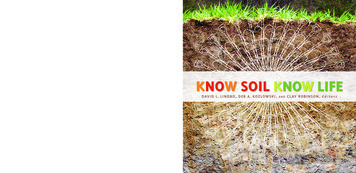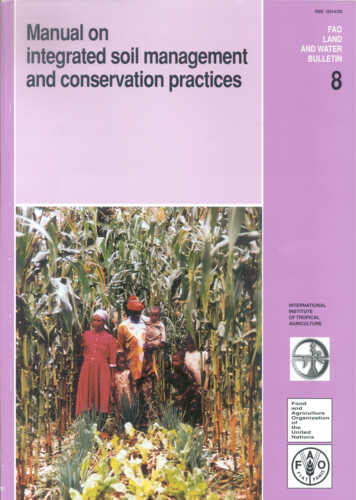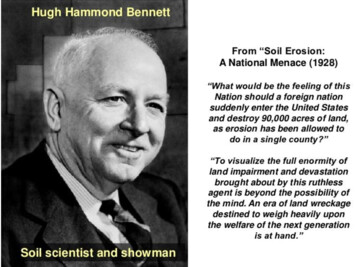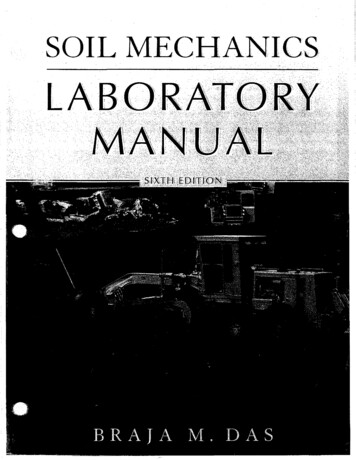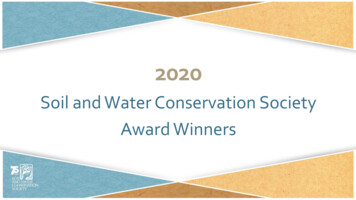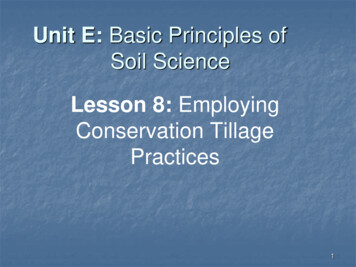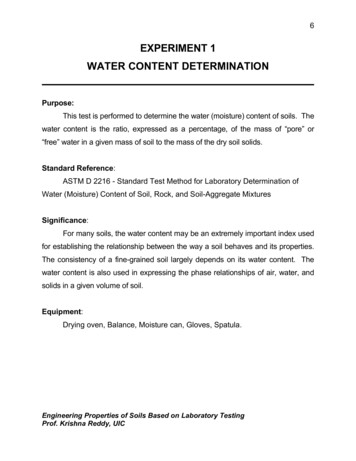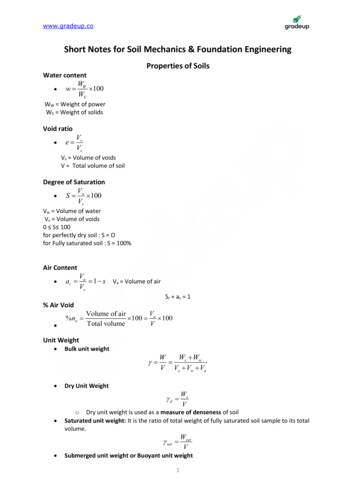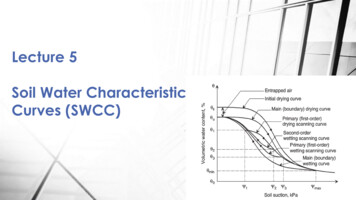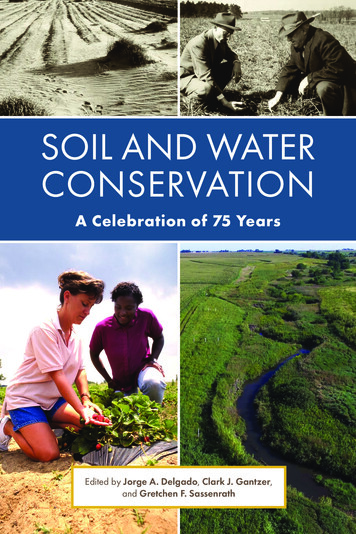
Transcription
SOIL AND WATERCONSERVATIONA Celebration of 75 YearsEdited by Jorge A. Delgado, Clark J. Gantzer,and Gretchen F. Sassenrath
Soil and Water Conservation: A Celebration of 75 YearsSOIL AND WATERCONSERVATIONA Celebration of 75 Years(c) SWCS. For Individual Use Onlyi
ii(c) SWCS. For Individual Use Only
Soil and Water Conservation: A Celebration of 75 YearsSOIL AND WATERCONSERVATIONA Celebration of 75 YearsEdited by Jorge A. Delgado, Clark J. Gantzer,and Gretchen F. Sassenrath(c) SWCS. For Individual Use Onlyiii
ivSoil and Water Conservation Society945 SW Ankeny Road, Ankeny, IA 50023www.swcs.org 2020 by the Soil and Water Conservation Society.All rights reserved.Project Manager and Copy Editor: Annie BinderDesigner: Jody ThompsonCover photos: Upper left—Wind-devastated farmland during the DustBowl, Kansas, USDA NRCS photo. Upper right—Hugh HammondBennett (right), first Chief of the Soil Conservation Service, USDA NRCSphoto. Lower left—Landowner and FAMU farm management specialistinspect strawberries grown as U-Pick operation, Campbellton, Florida,USDA NRCS photo by Bob Nichols. Lower right—Post-installationsaturated buffer, Story County, Iowa, USDA NRCS/SWCS photo byLynn Betts.Printed in the United States of America54321ISBN 978-0-9856923-2-2 (print)ISBN 978-0-9856923-3-9 (electronic)Library of Congress Control Number: 2020948295The Soil and Water Conservation Society is a nonprofit scientific andprofessional organization that fosters the science and art of naturalresource management to achieve sustainability. The Society’s memberspromote and practice an ethic that recognizes the interdependence ofpeople and their environment.Justice, Equity, Diversity, and Inclusion: SWCS seeks diverse voices,actively listens, engages in dialogue, thinks critically, and takesmeaningful action toward creating institutions and systems that serveand value people equally.(c) SWCS. For Individual Use Only
Soil and Water Conservation: A Celebration of 75 YearsvContentsForewordClare Lindahl and Annie BinderviiAcknowledgementsixDedicationx1The Soil and Water Conservation Society: The Society’s BeginningClark J. Gantzer and Stephen H. Anderson12Advancing Climate Change Mitigation in Agriculture while MeetingGlobal Sustainable Development GoalsRattan Lal123Ecological Embeddedness, Agricultural “Modernization,” and LandUse Change in the US Midwest: Past, Present, and FutureJ. Gordon Arbuckle Jr.324Social Understandings and Expectations: Agricultural Managementand Conservation of Soil and Water Resources in the United StatesLois Wright Morton425A History of Economic Research on Soil Conservation IncentivesSteven Wallander, Daniel Hellerstein, and Maria Bowman576Ecosystem Services Markets Conceived and Designed for US AgricultureDebbie Reed707Soil and Water Conservation Society and the Farm Bill: AHistorical ReviewJoseph W. Otto758Protecting Ecosystems by Engaging Farmers in Water Quality Trading:Case Study from the Ohio River BasinJessica Fox and Brian Brandt869Water Availability for Agriculture in the United StatesTeferi Tsegaye, Daniel Moriasi, Ray Bryant, David Bosch, Martin Locke,Philip Heilman, David Goodrich, Kevin King, Fred Pierson, Anthony Buda,Merrin Macrae, and Pete Kleinman9510 Water Optimization through Applied Irrigation ResearchMatt Yost, Niel Allen, Warren Peterson, and Jody Gale11511123Water QualityJorge A. Delgado12 Agricultural Drainage: Past, Present, and FutureVinayak S. Shedekar, Norman R. Fausey, Kevin W. King, and Larry C. Brown(c) SWCS. For Individual Use Only140
vi13 Seizing the Opportunity: Realizing the Full Benefits of DrainageWater ManagementCharles Schafer, Dave White, Alex Echols, and Thomas W. Christensen15314 Wetland Conservation in the United States: A Swinging PendulumDavid M. Mushet and Aram J.K. Calhoun16215 Accelerating Implementation of Constructed Wetlands onTile-Drained Agricultural Lands in Illinois, United StatesA. Maria Lemke, Krista G. Kirkham, Adrienne L. Marino, Michael P.Wallace, David A. Kovacic, Kent L. Bohnhoff, Jacqueline R. Kraft, MikeLinsenbigler, and Terry S. Noto17216 The Role of Soil Physics as a Discipline on Soil and WaterConservation during the Past 75 YearsFrancisco J. Arriaga, DeAnn R. Presley, and Birl Lowery17917 The Growing Role of Dissolved Nutrients in Soil andWater ConservationKenneth W. Staver18518 From Nutrient Use to Nutrient Stewardship: An Evolution inSustainable Plant NutritionLara Moody and Tom Bruulsema19719 Soil Biology Is Enhanced under Soil Conservation ManagementRobert J. Kremer and Kristen S. Veum20320 Soil Health: Evolution, Assessment, and Future OpportunitiesDouglas L. Karlen21221 Building Resilient Cropping Systems with Soil Health ManagementBarry Fisher22422 Climate Change, Greenhouse Gas Emissions, and CarbonSequestration: Challenges and Solutions for Natural ResourcesConservation through TimeJean L. Steiner and Ann Marie Fortuna22923 Conserving Soil and Water to Sequester Carbon and MitigateGlobal WarmingRattan Lal24124 Modeling Soil and Water ConservationDennis C. Flanagan, Larry E. Wagner, Richard M. Cruse, andJeffrey G. Arnold25525 From the Dust Bowl to Precision ConservationJorge A. Delgado and Gretchen F. Sassenrath27026 Developments in Midwestern Precision ConservationClay Bess28627 Cover Crops: Progress and OutlookEileen J. Kladivko29328 Marketing Conservation Agronomy: Cover Crops from TwoPractitioners’ Points of ViewSarah Carlson and Alisha Bower30329 The Future of Soil, Water, and Air ConservationJorge A. Delgado, Clark J. Gantzer, and Gretchen F. Sassenrath307(c) SWCS. For Individual Use Only
Soil and Water Conservation: A Celebration of 75 YearsviiForewordIt is an honor to bring you Soil and Water Conservation: A Celebration of 75 Yearsand serve as staff during our organization’s 75th anniversary. This year hasgiven us, as an organization, the opportunity to reflect on how we started,where have been, and where we are now.When we first discussed plans to commemorate the 75th anniversary ofthe Soil and Water Conservation Society (SWCS), leadership had three goals:(1) to celebrate the work and accomplishments of conservation professionals,(2) to celebrate achievements of the Society, and (3) to provide a thoughtfuldialogue on the future of conservation. During our 74th annual conferencein Pittsburgh, the Journal of Soil and Water Conservation editorial board enthusiastically supported these ambitions and formed a committee to develop acollection of essays that would reflect on the state of conservation science andpractice. The efforts of three dedicated editors and long-time SWCS members—Jorge A. Delgado, Clark J. Gantzer, and Gretchen F. Sassenrath—as wellas dozens of expert authors and reviewers have resulted in an exceptionalpublication that more than achieves our goals.Authors were given the formidable task of describing their areas of workin soil and water conservation, challenges of the past, progress in the last 75years, and future goals and opportunities. In addition to 20 chapters with aconservation science and research focus, 9 chapters providing a “Practitioner’sPerspective” highlight on-the-ground experiences through current projects,case studies, and practice implementation. While the chapters serve as introductions to complex and critical topics, many authors have included thoroughreferences and resources for readers wishing to learn more.Reviewing the important solutions presented in this collection, we ask thequestion: Could our organization’s founder, Hugh Hammond Bennett, haveever anticipated the developments of the past 75 years—modeling, remotesensing, tools and partnerships made possible through an increasingly globalized world—or the complexity of the challenges that conservationists face today under pressures of a changing climate and growing populations? CouldBennett have imagined the dynamic assortment of conservation professionals(c) SWCS. For Individual Use Only
viiithat SWCS has assembled 75 years later? Would he have predicted theirmany contributions that have created a promising future for agriculture, theenvironment, and society? This collection, completed in just over a year, is atestament to the passion that our members and partners have for sharing theirknowledge and communicating their work to a broad audience.In exploring the past 75 years of human relationships to agriculture and theenvironment, conservation efforts, and our organization through these pages,a coherent story emerges: the devastation of the Dust Bowl; developments infertilizer, crop, and equipment technology; the environmental movement ofthe 1960s and 1970s; shifts in policy and funding; effects of a changing climate;and renewed attention to soil health. Most evident to us, however, are themany diverse individuals and organizations whose contributions have had arole in advancing our understanding of soil and water conservation. It is theirefforts that we mark in this collection and their commitment to stewardshipthat we seek to sustain. We must continue to learn from one another, findopportunities for partnership and collaboration, and share the conservationstory. It is this community of conservation professionals who work tirelesslyto understand, protect, and improve our natural resources that was at the center of the conservation movement 75 years ago, just as it is today.Clare LindahlCEO, Soil and Water Conservation SocietyAnnie BinderDirector of Publications, Soil and Water Conservation Society(c) SWCS. For Individual Use Only
Soil and Water Conservation: A Celebration of 75 YearsixAcknowledgementsThe editors wish to acknowledge and give our profound thanks to AnnieBinder and Jody Thompson of the Soil and Water Conservation Society andto Donna Neer with the USDA Agricultural Research Service for their helpand contributions in editing and layout of the chapters of this collection. Weespecially extend our gratitude to Annie Binder, who worked closely with theauthors of all the chapters of this book, completed in less than a year from thestart of the project and published in time to celebrate the 75th anniversary ofthe Soil and Water Conservation Society in 2020.We also wish to give special thanks to all the book chapter authors, whosecontributions contributed to a high-quality product and whose timely composition and revision of the chapters helped keep the project on schedule.Finally, we wish to express our deep appreciation of all the reviewers foreach chapter, whose recommendations contributed to the improvement ofthe book.This work is supported by the USDA National Institute of Food andAgriculture Hatch Regional W4147.(c) SWCS. For Individual Use Only
xDedicationThe 20th century was an era of tremendous challenges related to soil and waterconservation. A few examples that readily come to mind are those of the early1930s, such as the Dust Bowl and agricultural systems with depleted nutrientbalances that reduced yields, as well as high erosion rates that degraded soiland water resources.During this challenging time, policymakers, the private industry, andother conservationists worked together to find solutions and develop policiesand best management practices. Through their efforts, a new approach toconservation agriculture emerged that contributed to a golden era in soil andwater conservation. One of the key figures of this era was Hugh HammondBennett, a founding member of the Soil and Water Conservation Society andthe first chief of the US Department of Agriculture’s Soil Conservation Service(known today as the Natural Resources Conservation Service).Global population growth had created an urgent need to increase agricultural productivity to feed the world by the 1950s, and the aforementioned groups, with plant breeders and soil fertility and nutrient managers,worked to develop a new response. The era of the Green Revolution andmore intensive agriculture significantly increased yields and helped to feedpeople around the world. One of the great leaders of this time was NormanBorlaug, the “father of the Green Revolution,” who received the NobelPeace Prize in 1970.In the last few decades, great new challenges have emerged, driven bya changing climate with extreme weather events, the ever-present need tocontinue to increase agricultural productivity to feed the growing humanpopulation, and losses of nutrients from agricultural systems that have impacted water quality, among other challenges. A new approach was neededand called for a similar team of professionals such as those that contributedto the golden era of soil and water conservation in the 1930s and the GreenRevolution in the 1950s and 1960s. In the 1970s and 1980s, we started to usegeographic information systems (GIS) and computers in agriculture, and bythe 1990s and 2000s, we were increasingly using global positioning systems(c) SWCS. For Individual Use Only
Soil and Water Conservation: A Celebration of 75 Yearsxi(GPS), GIS, remote sensing, and modeling to apply precision agricultureand precision conservation in the present era of smart agriculture.The next 75 years will likely witness a new era of modeling, genetic andbioengineering, microbiology, machine learning, artificial intelligence, robotics, drones, and other scientific and technological advances for soil andwater conservation.Each of these eras—past, present, and future—are distinct in their challenges, successes, lessons learned, and opportunities. This book aims tohonor and thank all those personnel who contributed to the soil and waterconservation success stories of the past, to celebrate those working tirelessly to tackle the challenges of the present day, and inspire those who willcontribute to future achievements in the emerging era of machine learning,artificial intelligence, robotics, and genetic and bioengineering to protectsoil and water resources for agricultural systems and increase the health ofsoils, crops, and animal systems. In addition, this book is dedicated to allthe professionals of these past, present, and future eras working to conservesoil and water resources in natural systems, such as foresters, biologists,ecologists, and the many other professionals whose work also contributes toconservation of the biosphere.(c) SWCS. For Individual Use Only
xii(c) SWCS. For Individual Use Only
1The Soil and Water ConservationSociety: The Society’s BeginningClark J. Gantzer and Stephen H. AndersonThe Soil and Water Conservation Society (SWCS) has provided excellent leadership in conservation over the past 75 years. As this special collection of essayscelebrates progress made and identifies challenges of today, it is important tokeep in mind the goals and achievements of SWCS founders and members.This effort traces the Society’s beginning and the successes of its work “to fosterthe science and art of natural resource conservation” during its first 50 years.Discussions on the initial organization, annual meetings, business, Societyleadership, and the Journal of Soil and Water Conservation (JSWC) are included,focusing on publications and published testimonies that have been a leadingmeans by which the Society has advanced soil and water conservation.The focuses of the earlier work of the Society continue today. As WaynePritchard, the first executive secretary of the Soil Conservation Society ofAmerica (SCSA; later renamed in the 1980s to the Soil and Water ConservationSociety), stated in 1984, the real key to the future is the work and planning oflandowners and farmers (Browning et al. 1984).Before the Formation of the SocietyIn the early 1900s, recognition of the need for an inventory of soils led to theestablishment of the US Department of Agriculture (USDA) State AgriculturalExperiment Station cooperative soil survey. The survey documented thevariation in soils and the need for different soil management techniques toincrease productivity and to control erosion.Clark J. Gantzer is an emeritus professor of soil and water conservation, andStephen H. Anderson is a professor of soil physics, in the School of NaturalResources at the University of Missouri, Columbia, Missouri.(c) SWCS. For Individual Use Only
2The formation of the SWCS could not have occurred without the leadership of Hugh Hammond Bennett, who has since been called the father of soilconservation. Bennett studied geologyand chemistry, and graduated from Figure 1the University of North Carolina in theBennett’s sheet erosion. Photospring of 1903 (Cook and Lawrenceby C.M. Woodruff.2015). Bennett said that it was an accident that caused him to take a job withthe Bureau of Soils. His assignmentwas work on soil classification andmapping and observation of soil productivity. Bennett and Bill McClendonof South Carolina introduced the term“sheet erosion,” in contrast to rill andgully erosion, which had been the usual field clues for identifying soil erosionproblems (figure 1).Amazingly in 1909, Milton Whitney,Chief of the Bureau of Soils, arguedthat the soil was of inexhaustible andpermanent fertility: “The soil is theone indestructible, immutable assetthat the Nation possesses. It is the oneresource that cannot be exhausted; thatcannot be used up.” Bennett angrily reacted to Whitney’s statement, saying,“I didn’t know so much costly misinformation could be put into a single briefsentence” (Cook and Lawrence 2015).In 1914, F.E. Duley and M.F. Miller at the University of Missouri, established the first experiment plots to measure factors affecting runoff and erosion (Gantzer et al. 2018). In 1928, Bennett included results from these plotsin his circular Soil Erosion—A National Menace (Bennett and Chapline 1928). In1939, Bennett indicated that publication was critical in securing public and political attention to soil erosion (Bennett 1939). The importance of erosion wasalso highlighted by Walter Lowdermilk’s report Conquest of the Land Through7,000 Years, which contained erosion studies Lowdermilk made around theworld between 1938 and 1939 (Lowdermilk 1953).In 1929, due to his friendship to Arthur B. Conner, director of the TexasExperiment Station who argued that “protecting the soil that supportsthe citizenship protects the nation,” Bennett was invited to testify beforeCongressman Buchanan’s subcommittee and secured an amendment attached(c) SWCS. For Individual Use Only
Soil and Water Conservation: A Celebration of 75 Years3to the 1929 appropriation for the Department of Agriculture authorizing 160,000 over four years for soil erosion research. Bennett used the earlierMissouri erosion plot design for the first 10 USDA erosion experiment stations nationwide. This money was to be used “to investigate the causes of soilerosion and the possibility of increasing the absorption of rainfall by the soil”(Gantzer et al. 2018). Astonishingly, the loss of nutrients from erosion wasgreater than expected and was often greater than that by removal from crops.Nitrogen (N) loss was especially noted since it is found largely in the surfacesoil, which is most easily removed through erosion.The dust storms of the 1930s accelerated nationwide soil erosion programs.The first great dust storm occurred on May 11, 1934, and blew soil from theGreat Plains to Washington, DC. Bennett used this disaster to alert Congressand the nation to the need to protect farmland, and by lobbying Congress,helped to enact Public Law 46, which established the Soil ConservationService (SCS) in 1935. Bennett’s biography provides additional informationabout his important historical role as the first chief of the SCS as well as thefounder of the SWCS who “started and organized—for conservation of ournatural resources and for a better agriculture.” Bennett dramatized the criticalneed of soil and water to politicians, and then formulated soil and water conservation practices and pressed forward to translate theory into action on theland (Brink 1951).Another early leader in US conservation was Aldo Leopold, who introducedthe idea of “environmental ethics” and appreciated comprehensive farm conservation through demonstration projects that extended land husbandry toinclude wildlife. This concept agreed with Bennett’s belief that each acre on afarm or ranch should be “used for and treated in accordance with its capabilities” (Leopold 1949; Cohee 1987). In 1933 Leopold worked to integrate wildlifemanagement into the nation’s first soil conservation watershed demonstration,the Coon Creek project in Wisconsin (Cohee 1987; Meine 1987).The Society’s Inception in the 1940sThe Society’s inception was in 1941 when Bennett, Ralph H. Musser, A.E.McClymonds, and J.H. Christ proposed founding an organization titled“The American Society of Soil and Water Conservation.” In a 1943 meetingin Washington, DC, Musser stated, “An organization of this kind should beworthy of the people interested in work in soil and water conservation, and itshould be the medium of expression of the people of this profession.”The name of the organization, “Soil Conservation Association of America,”was introduced in the Society’s first publication of Notes and Activities in Aprilof 1945. During a meeting that year, Bennett suggested a change in the name(c) SWCS. For Individual Use Only
4to “Soil and Water Conservation Association of America;” however, the membership voted to change the name to “Soil Conservation Society of America”(SCSA) (Pritchard 1956).The first SCSA chapter meeting was held in 1945 and included a keynote presentation focused on “Upstream Measures as They Relate to FloodControl.” In 1946 the first issue of the JSWC was printed. In 1949 the Journalpublished a Society statement on “National Land Policy” that said, “All landsshould be used in a manner which will insure its continued and permanentmaximum productivity and values . . . In a great measure, our natural economy, our democratic process and our national security are dependent on thefuture conservation and use of our basic natural resources” (Pritchard 1965).The fourth annual meeting of the Society was in St. Louis, Missouri, andproceedings were reported by national press, including The New York Times.Additionally in these early years, A. Dams published a highly cited paper,“Loss of Topsoil Reduces Crop Yields” (Pritchard 1956).Soil Conservation Society of America in the 1950sThe Society’s effort to educate the public about soil and water was advancedby the publication of the booklet Down the River (1951). Over 200,000 copieswere printed. It presented the causes of erosion and described methods ofconserving both soil and water for a lay audience. In 1951 C.C. Taylor’s article“Conservation: A Social and Moral Problem” was selected as the outstandingJournal article.In January of 1952 the Society’s first full-time office opened. The JSWCincreased from a quarterly to bimonthly publication, and the article “Soil, theSubstance of Things Hoped For” by Firman E. Bear was awarded the outstandingarticle of the year. In 1953, the eighth annual meetingFigure 2was held in Colorado Springs, Colorado. A comThe Story of the Land.mittee was established to determine the meaningof the term “soil conservation,” and internationalsoil conservation activity was facilitated withproduction of the article “A Soil Erosion Survey ofLatin America” in the JSWC with cooperation ofthe Conservation Foundation and the Food andAgriculture Organization of the United Nations.In 1955 an educational cartoon booklet, TheStory of Land—Its Use and Misuse, was published(figure 2). Over 435,000 copies were sold by year’send. Ralph H. Musser testified for H.R. 8914, entitled the Farm Conservation Civil Defense Act of(c) SWCS. For Individual Use Only
Soil and Water Conservation: A Celebration of 75 Years51956, writing, “I am pleased to see the stress placed on the conservation ofour natural resources, particularly soil, water, forestry, and wildlife.” WaynePritchard wrote, “Your proposal to combine conservation and a farm programwith a civil defense program is a new approach to the total problem that needsto be accomplished. . . . the problem of conservation is a complicated one, andone in which we need to use many incentives because the urban citizen isdependent upon those who manage the agricultural land.”In 1957, the Society’s annual meeting emphasized urban and rural landplanning, and Douglas E. Wade became the first full-time editor of the Journal.Asheville, North Carolina, hosted the 1958 annual meeting with a theme of“Land and Water for Tomorrow’s Living.” There were a total of 1,139 attendees.In 1959, the annual meetFigure 3ing was held in Rapid City,South Dakota. A meetingUS Postal Service commemorative stamp.highlight was the issue ofa US Postal Service commemorative stamp honoringconservation and illustrating the importance of soilconservation measures, likecontour plowing and theplanting of cover crops (figure 3). Through arrangement with cartoonist Hank Ketcham, a cartoon publication, Dennis the Menace and Dirt (figure 4), was produced (Pritchard 1965).The federal Soil Bank Program (authorized by the Soil Bank Act, P.L.84-540, Title I) of the late 1950s and early 1960s paid farmers to retire landfrom production for 10 years. It was the predecessor of the ConservationReserve Program (CRP), where the government bought back submarginalland to reduce the need for the governmentFigure 4to support overproduction.Dennis the Menace and Dirt.Soil Conservation Society of Americain the 1960sThe 1960s introduced environmental events,including the book Silent Spring by RachelCarson (1962), which addressed the dangerof excessive use of pesticides; the WildernessAct of 1964; and the federal Water QualityAct of 1965. These issues related to land usewere of concern to the Society. To address(c) SWCS. For Individual Use Only
6them, SCSA published a 1960s position statement on “Land Use: Choices andChallenges.” It stated:National legislation has been directed toward certain types of land such asparks, wilderness areas, wetlands, and surface-mined lands. . . . However,the United States has not been able to develop and adopt an over-all landuse policy to help decisionmakers establish priorities when conflicts regarding land use occur. The nation needs to identify the importance of itsproductive agricultural land and develop ways to settle conflicts amongcompeting private interests and protect the public interest . . . improvedconservation measures must be considered now to help insure an adequate land resource base for the future. (Baum 1981)The theme of the 1960 annual meeting in Ontario was “New Technologiesin Land Resource Management.” This marked the first annual meeting to beheld in Canada and was attended by 1,256 people. Other 1960s topics included “Land Use: Changing Agriculture” and “Conservation—Key to WorldPeace.” In 1965 a speech on “National Forest Wilderness” was delivered at theannual meeting by Associate Chief of the Forest Service Greeley (Frome 1975;Pritchard 1965).Conservation work focused on the causes of lost soil productivity, and theJSWC published many papers on this topic. Peterson published “The Relationof Soil Fertility to Soil Erosion” (1964), Heilman and Thomas reported on “LandLeveling Can Adversely Affect Soil Fertility” (1961), and Eck and Ford wroteabout “Restoring Productivity on Exposed Subsoils” (1962). Shrader et al. published an important paper on “Applying Erosion Control Principles” in 1963.Development of the Universal Soil Loss Equation for advancing and designingerosion control systems was published by Wischmeier and Smith (1965).Additional important SCSA outreach activities in the 1960s included the Soiland Water Conservation Glossary published in Spanish in cooperation with theUS Agency for International Development. In 1964 a popular booklet, Makinga Home for Wildlife, was introduced at the 19th annual meeting. Also in 1964,Focus on Resource Conservation included articles on “Outdoor Recreation—ItsImpact Today,” “Policy in Land Management—A Symposium,” and “Usingand Managing Our Water Resources.” The first scholarships offered by theSociety were established during the 1960s.Soil Conservation Society of America in the 1970sThe 1970s ushered in the environmental movement. On January 1, theNational Environmental Policy Act was installed. Senator Gaylord Nelson(c) SWCS. For Individual Use Only
Soil and Water Conservation: A Celebration of 75 Years7initiated the first Earth Day, an environmental teach-in, on April 22, 1970,and the US Environmental Protection Agency was founded later that year.The Federal Water Pollution Control Act amendments of 1972 (Clean WaterAct), the Safe Drinking Water Act of 1974, and the Resource Conservationand Recovery Act (1976)—all landmark laws—were approved. The SurfaceMining Control and Reclamation Act of 1977, regulating strip mining, andthe Soil and Water Resources Conservation Act of 1977 were enacted andwere also of profound interest to the Society.Concern about excessive soil erosion increased. In 1977, average erosionrates in the United States exceeded 11 Mg ha–1 y–1 (5 tn ac–1 yr–1) for all rowcrops produced in the Southeast. In many counties, erosion rates exceeded 112Mg ha–1 (50 tn ac–1) on corn and soybean land. For conventional tillage, averageerosion was 21.5 Mg ha–1 y–1 (9.6 tn ac–1 yr–1); for chisel-plowing, soil loss was8.7 Mg ha–1 y–1 (3.9 tn ac–1 yr–1); and for no-tillage, just 6.5 Mg ha–1 y–1 (2.9 tn ac–1yr–1). A prescription to address the excessive erosion on sloping row crops musthave sizeable increases in sod crops in the rotation, contouring and terracing,or growing of winter cover crops to control erosion (Larson 1981).The prestige and distinction of the Society was greatly advanced by qualityjournal articles. The Journal published many papers, including Narayanan andSwanson’s (1972) “Estimating Trade-Offs Between Sedimentation and FarmIncome,” Anderson et al.’s (1975) “Perspectives on Agricultural Land Policy,”Lyles’s (1975) “Possible Effects of Wind Erosi
Soil and Water Conservation Celebration of 75 ears. vii. Foreword. It is an honor to bring you. Soil and Water Conservation: A Celebration of 75 Years . and serve as staff during our organization’s 75. th. anniversary. This year has . given us, as an organization, the opportunity to reflect
